The Stereo Singles Project
The Stereo Singles Project will consist of several discographies, and in the short run some will be more
complete than others. The first part will cover the stereo 45s issued during the industry's first stereo
single era, 1958-1961. The second part will cover stereo 33-1/3 rpm singles (one song on each side)
issued during the early 1960s, as it turned out, mostly for juke boxes. The third part will address the
7-inch, 33-1/3 rpm "Little LP" or "Juke Box LP" discs. Finally, Part 4 will cover the first few years of the
second stereo 45 era, starting in 1968 when the industry went to "compatible 45s" that played in stereo.
The "Speed Wars" of 1948-1950
To fully understand what happened when stereo singles were introduced in 1958, we must take a quick
trip back to the late 1940s. Before 1948, the industry "standard" disc ran at 78-2/3 rpm (usually called
just 78 rpm), and had done so since the 1890s, when the flat "gramophone records" replaced cylinder
recordings. Early records weren't always recorded exactly at this speed, sometimes even being recorded
at about 80 rpm or other speeds approximating 78. This variation is similar to more modern records
being "speeded up" to make the sound more peppy or make the vocalist sound younger. "Standards" for
microgroove width or volume weren't always established or followed in the early days of 45s or LPs,
either, but an extensive standards discussion is a topic for another time and place.
There were a lot of folks in the industry who felt that the 78s currently being made and sold were just fine,
and "if it ain't broke, don't fix it" or "we've always done it this way." The buying public, on the other hand,
considered the 78 to be bulky to store, easily broken, and difficult to deal with in stacks. And the country
was just coming out of World War II less than three years ago in 1948, with memories of a shellac
shortage and union problems/record bans leaving a somewhat negative feeling about the record industry
in general.
In those post-war years, the music scene was dominated by two huge industry giants, Columbia
Records, and RCA-Victor. (Capitol was just getting started, and Decca was big, but not particularly
innovative on the research side). These two labels were bitter rivals, and generally competed to see
which could drive the market with new innovations. Both companies were working on improvements to
the 78, improvements in handling and storage, improvement in freedom from the 78 surface noise,
improvements in freedom from distortion, as well as improved playing times (even 12" 78s had a limit of
about 6 minutes or so on each side, which was problematic for classical pieces, for example).
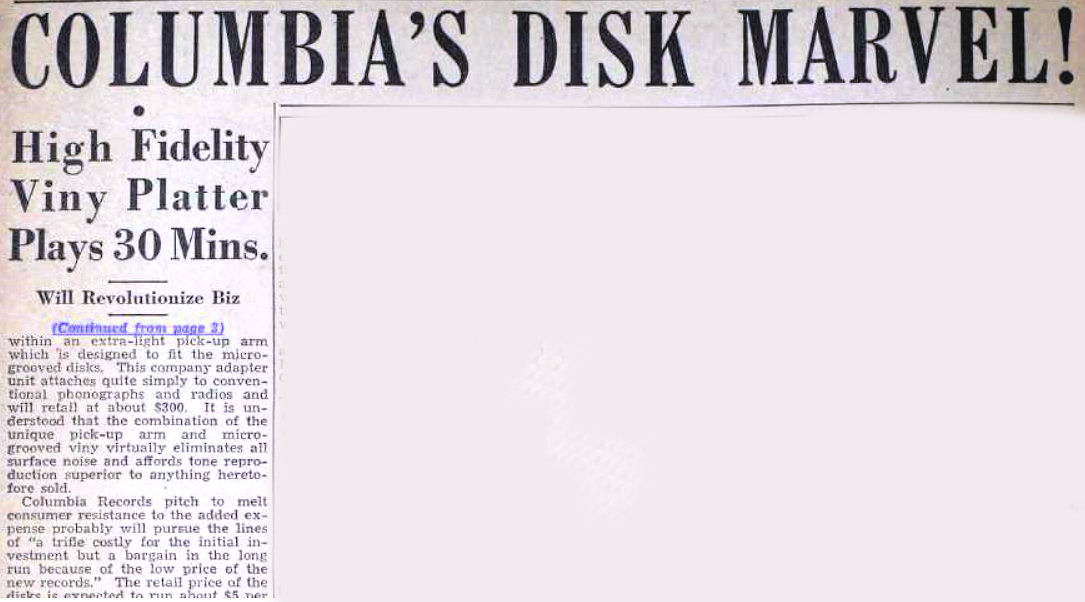 Both companies were known to be working on hush-hush projects to basically replace the 78. Columbia
got to the announcement stage first. In late May, 1948, Columbia announced a new type of record, one
that would run at 33-1/3 rpm and be pressed on vinyl. (RCA had
introduced a 33-1/3 rpm long playing disc in 1931, although this one offered several improvements.)
The new disc would, unlike the 78s, use a much smaller groove (microgroove) with an ultra light
tonearm and a new type of cartridge/stylus. They called the new innovation the Lp (big "L", small "p") for
"long playing." The new type of record minimized surface noise, the quiet backgrounds being perfect for
classical music, with longer playing times of 22 minutes or so per side for a 12" Lp. In fact, Columbia's
idea at the time was to use Lp for their Mastersound records, which is where the classical and other
highbrow music resided. The industry was energized by the news (see headline at right from
Billboard, 5/29/48). By the next week, phonograph makers were rushing to build units that could
play the new records, the first of which were due in June.
Both companies were known to be working on hush-hush projects to basically replace the 78. Columbia
got to the announcement stage first. In late May, 1948, Columbia announced a new type of record, one
that would run at 33-1/3 rpm and be pressed on vinyl. (RCA had
introduced a 33-1/3 rpm long playing disc in 1931, although this one offered several improvements.)
The new disc would, unlike the 78s, use a much smaller groove (microgroove) with an ultra light
tonearm and a new type of cartridge/stylus. They called the new innovation the Lp (big "L", small "p") for
"long playing." The new type of record minimized surface noise, the quiet backgrounds being perfect for
classical music, with longer playing times of 22 minutes or so per side for a 12" Lp. In fact, Columbia's
idea at the time was to use Lp for their Mastersound records, which is where the classical and other
highbrow music resided. The industry was energized by the news (see headline at right from
Billboard, 5/29/48). By the next week, phonograph makers were rushing to build units that could
play the new records, the first of which were due in June.
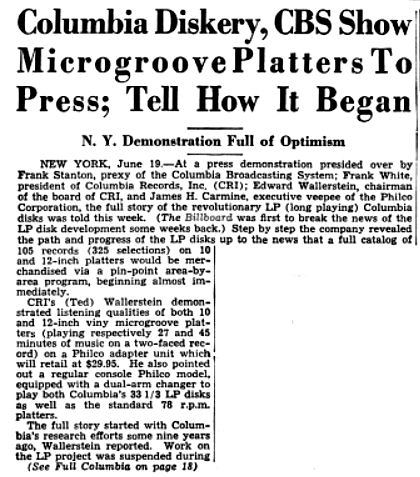 In June, Columbia held a "technical press conference" in New York for industry folks, explaining the
development process for the Lp, demonstrating the discs, and going through all the technical
specifications (Billboard story, 6/26/48, at left). They talked about the availability of phonographs.
They also offered their new technology to any other labels who wanted them. Labels like the brand-new
Mercury Records jumped at the offer, but RCA-Victor declined.
In June, Columbia held a "technical press conference" in New York for industry folks, explaining the
development process for the Lp, demonstrating the discs, and going through all the technical
specifications (Billboard story, 6/26/48, at left). They talked about the availability of phonographs.
They also offered their new technology to any other labels who wanted them. Labels like the brand-new
Mercury Records jumped at the offer, but RCA-Victor declined.
For the rest of 1948, Columbia was busy getting a catalog of 105 new Lp records together, most on 10"
but some on 12", mostly reissues of old 78 material, and everything looked bright. But there was still a
nagging rumor that RCA-Victor had their own secret project that would change everything, again. The
other shoe dropped in December, 1948, when a Billboard editorial (12/4/48, Page 3) revealed
that RCA was working on a 45-rpm single which would be easy to carry and store. Albums would be
done by booklets of 45s.
Columbia immediately countered by announcing January 8, 1949, that henceforth all their singles would
be issued on both 78-rpm and on 7", 33-1/3 rpm discs. By January 15, before RCA could get any 45s
on
the market, Columbia was already announcing their price structure for 33-singles. In a somewhat self-
congratulatory statement, Edward Wallerstein, Chairman of the Board of Columbia Records, announced,
"It is the logical step in the completion of the revolutionary technique established when we introduced the
microgroove system six months ago." (Billboard, 1/15/49, Page 20)
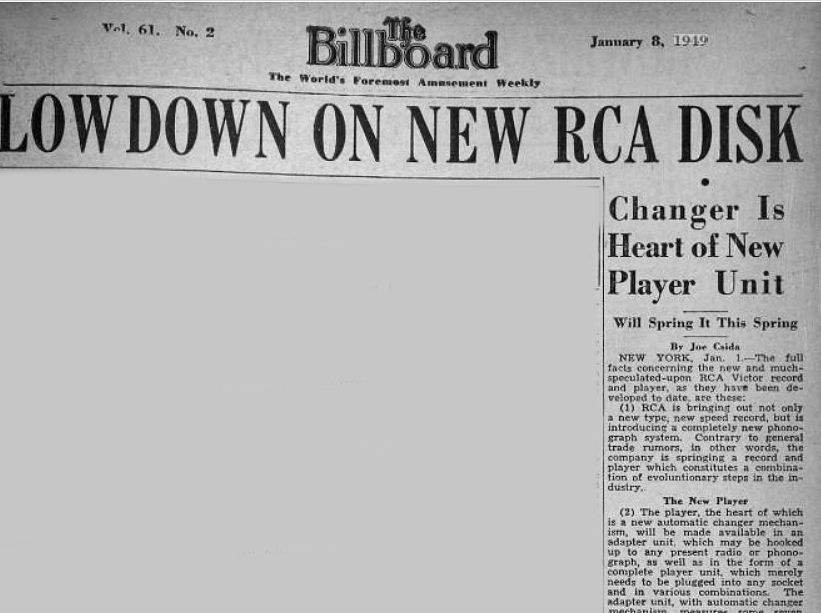 Also on January 8, 1949, a story in Billboard (page 3) revealed details of the new RCA-Victor 45
rpm disc. Unlike the 78s of the time, or Columbia's Lp, it would have a large 1-5/8" hole in the center,
and would work with a new RCA record changer with the thick spindle. The record, measuring 6-7/8
inches in diameter, would use only about an inch of the outside of the record for grooves. RCA
engineers had designed it "with the express objective of achieving 100 percent undistortion, or put
another way, creating a record which is completely free of surface noises or distortion of any kind."
Persons at the time who heard the new disc reported that as far as they could tell, RCA engineers had
accomplished their goal.
Also on January 8, 1949, a story in Billboard (page 3) revealed details of the new RCA-Victor 45
rpm disc. Unlike the 78s of the time, or Columbia's Lp, it would have a large 1-5/8" hole in the center,
and would work with a new RCA record changer with the thick spindle. The record, measuring 6-7/8
inches in diameter, would use only about an inch of the outside of the record for grooves. RCA
engineers had designed it "with the express objective of achieving 100 percent undistortion, or put
another way, creating a record which is completely free of surface noises or distortion of any kind."
Persons at the time who heard the new disc reported that as far as they could tell, RCA engineers had
accomplished their goal.
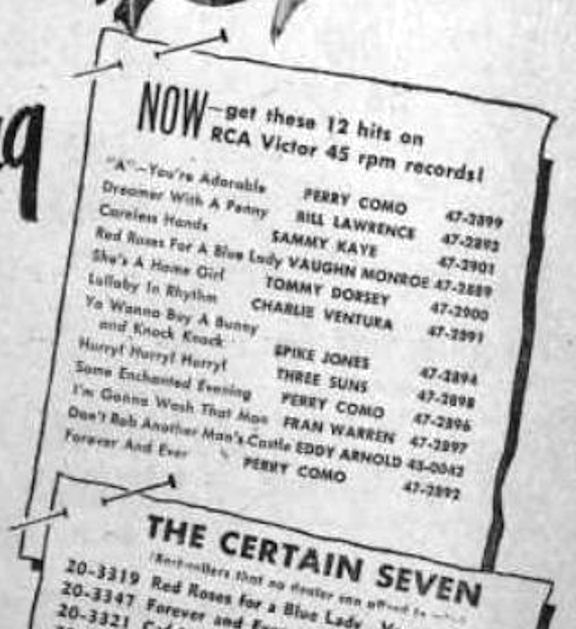 The long Billboard story on January 8 concluded this way: "While wiseacre trade comment anent
RCA's new disk has run along the general lines that the diskery would not sit still for Columbia beating
them to the punch with the 33 1/3 long-playing platter, that RCA would find a way of "getting even," the
facts behind the new system are these: As is the custom with all its many products, engineering
research has gone on in the record division for a long time. As far back as late 1938 the RCA engineers
were diddling, not with a new type record, but with a complete phonograph system, which would give
completely undistorted music. The record player which will be introduced in March or April of 1949 were
actually developed for all practical purposes in late 1946.... In the summer of 1948 when Columbia
introduced its long playing 33 1/3 microgrooved disk and won the support of key instrument
manufacturers, RCA decided the time had come to get serious about introducing their own version of a
new standard. In view of the engineering research, production and other planning necessary to ready
and launch such an item it seems ridiculous to believe that pique over the Columbia move dictated the
RCA entry... However, there is little doubt that the introduction of the new RCA player and platter in the
spring will mark the beginning of a historic disk battle between the Camden characters [RCA] and the
Columbia gang from Bridgeport." Speed wars, indeed.
The long Billboard story on January 8 concluded this way: "While wiseacre trade comment anent
RCA's new disk has run along the general lines that the diskery would not sit still for Columbia beating
them to the punch with the 33 1/3 long-playing platter, that RCA would find a way of "getting even," the
facts behind the new system are these: As is the custom with all its many products, engineering
research has gone on in the record division for a long time. As far back as late 1938 the RCA engineers
were diddling, not with a new type record, but with a complete phonograph system, which would give
completely undistorted music. The record player which will be introduced in March or April of 1949 were
actually developed for all practical purposes in late 1946.... In the summer of 1948 when Columbia
introduced its long playing 33 1/3 microgrooved disk and won the support of key instrument
manufacturers, RCA decided the time had come to get serious about introducing their own version of a
new standard. In view of the engineering research, production and other planning necessary to ready
and launch such an item it seems ridiculous to believe that pique over the Columbia move dictated the
RCA entry... However, there is little doubt that the introduction of the new RCA player and platter in the
spring will mark the beginning of a historic disk battle between the Camden characters [RCA] and the
Columbia gang from Bridgeport." Speed wars, indeed.
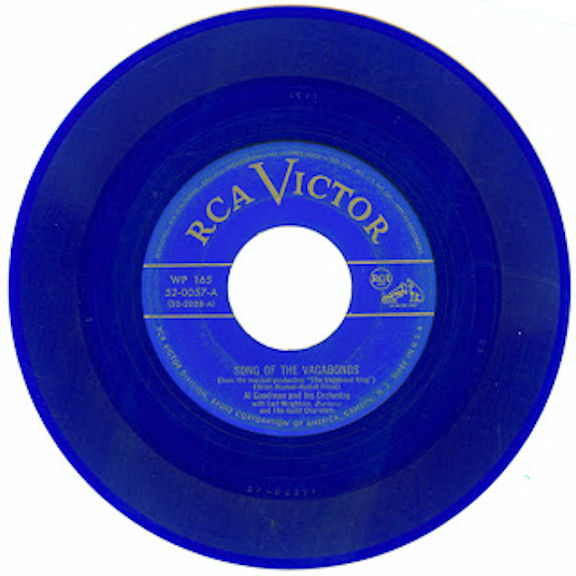 RCA made the first 12 45-rpm singles available the week of April 16, 1949, and announced that starting
with the April 29 release, all new releases would be made on both 45-rpm and 78-rpm discs. The
advertisement above left is from the April 23, 1949, issue of Billboard, and marks the first time
45-rpm singles were available. With the release of these singles, customers noticed an interesting
bonus: they were all on colored vinyl, with "popular classics" (Broadway musicals and operettas) having
a dark blue label and dark blue vinyl , green labels and vinyl for country, yellow vinyl with a dark blue
label for childrens' records, a crimson red label and vinyl for classical music, rhythm and blues on cerise
(orange) vinyl with a flat black label (often hard to read, and often these records had very low volume),
and international with a shiny black label on teal vinyl. Regular pop singles were issued on black vinyl
with blue labels. It was a matter of only a year or two, however, before RCA started pressing all the 45s
on black vinyl.
RCA made the first 12 45-rpm singles available the week of April 16, 1949, and announced that starting
with the April 29 release, all new releases would be made on both 45-rpm and 78-rpm discs. The
advertisement above left is from the April 23, 1949, issue of Billboard, and marks the first time
45-rpm singles were available. With the release of these singles, customers noticed an interesting
bonus: they were all on colored vinyl, with "popular classics" (Broadway musicals and operettas) having
a dark blue label and dark blue vinyl , green labels and vinyl for country, yellow vinyl with a dark blue
label for childrens' records, a crimson red label and vinyl for classical music, rhythm and blues on cerise
(orange) vinyl with a flat black label (often hard to read, and often these records had very low volume),
and international with a shiny black label on teal vinyl. Regular pop singles were issued on black vinyl
with blue labels. It was a matter of only a year or two, however, before RCA started pressing all the 45s
on black vinyl.
By May, 1949, phono manufacturers were turning out machines with three speeds, 78, 45, and 33.
Well, Columbia and RCA-Victor stubbornly held onto their speeds, but it couldn't last. The marketplace
had the final decision. In the January 7, 1950, issue of Billboard, [page 21], RCA came out with a
new policy that henceforth, they would issue albums on 33-1/3 rpm. This was an admission that their
idea of "albums" being a collection of 45s wasn't going well relative to Columbia's 10" and 12" albums.
But of course in their statement, they just had to say, "To serve those music lovers who wish to play
certain classical selections on long-playing records, RCA Victor will introduce on or about March 1, a
new and improved, unbreakable long-playing record." [emphasis mine]. Even in defeat, a sideways
dig at Columbia.
Columbia was no more gracious. In the August 12, 1950, issue of Billboard, [page 15], Columbia
essentially conceded that their 33-1/3 rpm single was unpopular with buyers relative to the RCA 45, but
of course had to do it by saying, "Having developed a better 45 r.p.m. record, CRI [Columbia
Records, Inc.] will release two of its popular hits on 45 r.p.m. microgroove records in several test
markets." [emphasis mine]. The speed wars were over.
Or were they?
The Introduction of Stereo on Vinyl
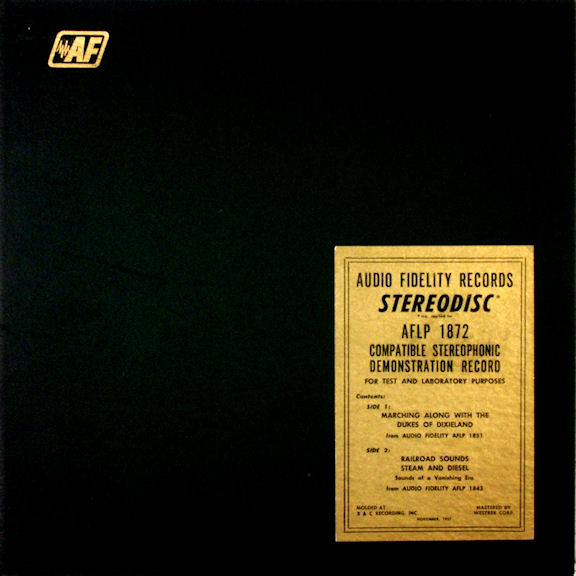 Stereophonic sound was not new in the late 1950s. People were investigating stereo as early as the
1880s, and probably long before that. Bell Laboratories in New York City gave a demonstration of
stereo in 1937, and motion pictures started using some of the techniques around the same time. Walt
Disney's Fantasia was partly recorded in stereophonic sound, which was restored in 1956.
Movies as early as 1953 let viewers in theaters hear the films in stereo. By 1955, recorded music was
being offered to the public on four-track (two-tracks each direction) reel-to-reel tape. The challenge was
how to bring stereo to disc.
Stereophonic sound was not new in the late 1950s. People were investigating stereo as early as the
1880s, and probably long before that. Bell Laboratories in New York City gave a demonstration of
stereo in 1937, and motion pictures started using some of the techniques around the same time. Walt
Disney's Fantasia was partly recorded in stereophonic sound, which was restored in 1956.
Movies as early as 1953 let viewers in theaters hear the films in stereo. By 1955, recorded music was
being offered to the public on four-track (two-tracks each direction) reel-to-reel tape. The challenge was
how to bring stereo to disc.
Various experiments along those lines for decades had been unsuccessful in developing a commercially
viable way. The problem had two major facets, first to get it to work, and second to make the records
mass-producible. In 1952, Emory Cook divided the two recorded tracks into two separate mono grooves,
one near the edge and one near the hub, with two mono tonearms connected to separate mono sound
systems. It was not practicable for commercial use, but Cook developed more than 25 stereo records
with this setup.
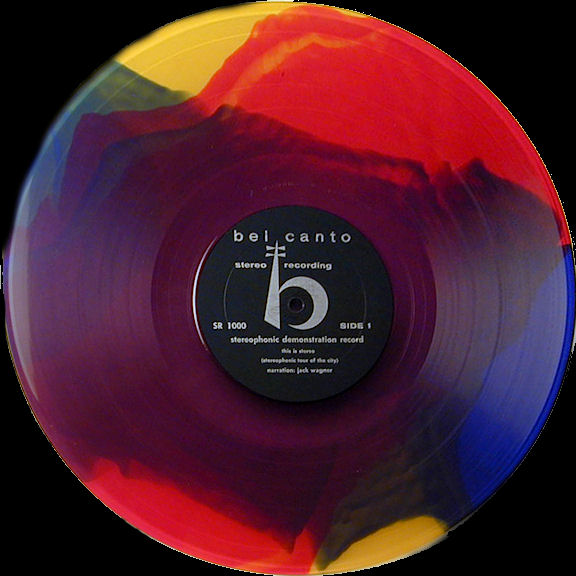 Audio Fidelity Records was the first to solve both problems. They developed a system for stereo on vinyl
records in 1957 with several prototype demonstration discs, but problems with reproduction on a mass
scale left the industry skeptical. On December, 13, 1957, they stunned the industry with an actual
workable, mass-produced disc that had gone through a press run of 500 copies. Unlike previous
attempts by others, this disc required only a single stylus. The first stereo disc had The Dukes of
Dixieland on one side and train sounds on the other (see above right).
Audio Fidelity Records was the first to solve both problems. They developed a system for stereo on vinyl
records in 1957 with several prototype demonstration discs, but problems with reproduction on a mass
scale left the industry skeptical. On December, 13, 1957, they stunned the industry with an actual
workable, mass-produced disc that had gone through a press run of 500 copies. Unlike previous
attempts by others, this disc required only a single stylus. The first stereo disc had The Dukes of
Dixieland on one side and train sounds on the other (see above right).
Bel Canto Records, who had been recording in stereo for tape for some time, within days produced a
stereo disc that could be used by dealers for demonstration. The Bel Canto discs were on colored vinyl
(see left), and were meant to play on demonstration stereo machines lighted from under a transparent
turntable so the light would shine through the colored wax.
It took most labels several months to gear up for releasing stereo albums.
During this time, the industry was wrestling with many problems, and as usual, bickering amongst
themselves at the introduction of a new format. The Audio Fidelity format, which used lateral and vertical
components in a groove with information on each side of a 45/45 degree groove, required a cartridge
(which holds the stylus, or "needle") that could move vertically as well as horizontally. The standard
mono cartridges could only move horizontally, and mechanically, when playing a stereo record, could
shear off some of the tiny informational bumps in the grooves, damaging the record. For that reason,
stereo records could not be played on mono players without damage, so they were "incompatible."
Let's listen in on the conversation...
March 31, 1958, Billboard, Page 2:
'Compatible' Disk Unveiled; Wide Discussion in Trade
New York - Counting up all the activity of the week among several alphabetical agencies, such as the
EIA, the IRE and the RIAA, it was a busy time for the struggling upstart known as the stereo disk.
Discussions on compatibility and known releases of stereo disks upcoming from a number of labels
comprised the main activity.
Interest in meetings of the Electronics Industry Association, the Institute of Radio Engineers, and the
Record Industry Association of America focused principally on a compatible stereo record developed
and announced by Dr. Peter Goldmark of CBS Laboratories. According to Goldmark's paper, delivered
to engineers attending the IRE at the Waldorf Convention, the CBS compatible disk employs a principle
of "sum and difference signals" under which, in effect, the vertical signal of the dual track recording is
reduced.
In this way the element of record wear, one of the inherent dangers of playing stereo records on
monaural equipment, would be virtually nullified. It was claimed the record would be compatible for
present day phonos and would still produce a stereo sound when played on stereo equipment.
Disk Execs Wary
According to reports eminating from the RIAA board meeting on Wednesday (26), the reaction of most
diskery execs to this concept was not favorable. The consensus seemed to be that by employing this
system, true stereo would be sacrificed in the interest of obtaining compatibility.
A spokesman for Westrex later said that "any system which tended to tailor down the best attributes of
stereo to meet certain commercial considerations would be undesirable.
Some ideas never die, though. Interestingly, a similar "sum and difference" system was used in the
1970s for some of the quadraphonic records (SQ, QS) which "derived the back two channels." Contrast
that with Elektra's discrete quad, which had four separate channels.
In a separate story on page 2, various label executives' views were given:
George Marek, RCA Victor chief, noted that Victor as well as Columbia had a so-called compatible
disk, and that he took a dim view of both. He added, "We believe these disks are wrong, and will always
be wrong. When you compromise, you get a disc which is not as good as the current monaural one on
the market.... This is a step backwards because you are not producing a record as good as possible.... A
miracle may happen at some point in the future, but now, and for the forseeable future, we feel a
compromise disk is wrong for the business."
Capitol Records states that it has tested stereo records purported to be compatible, and finds that they
are not up to monaural standards and also fall short on the stereo end. The firm believes that it is
possible to make stereo records closely equaling the quality of stereo tapes, and to compromise quality
to achieve compatibility does not seem "like good judgment."
Mercury prexy Irving B. Green stated that a compatible disk represents a compromise with quality and
that the stereo fan is too discriminating to accept a compromise. "We'll put out a stereo disk at the
proper time," Green said, "and when we do it will be the finest stereo disk we can make." Green said he
is inclined to look at stereo as a permanently separate market from that of the standard L.P., that it will
never replace it.
Leonard Schneider, executive vice-president of Decca Records, reflecting the general point of view of
other spokesmen, summed it up in succinct fashion: "It is not necessary to elaborate. We simply object
to it because it is not wholly stereo."
On page 9, an interesting discussion about majors vs. independents, and the first discussions about fake
stereo are found:
The pattern of releases of stereo disks, as it has come to light, bears out the difference in viewpoints
between major and indie labels. None of the majors so far have shown any inclination to rush out with
stereo records. This is logical, say observers, in view of the tremendous monaural inventory extant in
the catalog of each. On the other hand, indies, some of whom have or will issue releases soon, have
nothing to lose.... Highly personalized interests of the majors might be interpreted in another way.
Those who might conceivably favor the idea of a monaural disk, gimmicked in the control room to
produce an impression of a stereo effect, might do so because of a shortage of catalog material actually
recorded in stereo. It is known that there is considerable variation in the amount of stereo-cut material in
various important catalogs. Obviously, it's pointed out, those who started recording in stereo longest
ago would be most in favor of the "true stereo" concept.
Say it isn't so! Here's evidence that rechanneled or fake stereo was present at the very beginning, or
even before the beginning, before almost any of the record labels put out any stereo records at all!
As far as stereo album releases in late March, 1958, there weren't many:
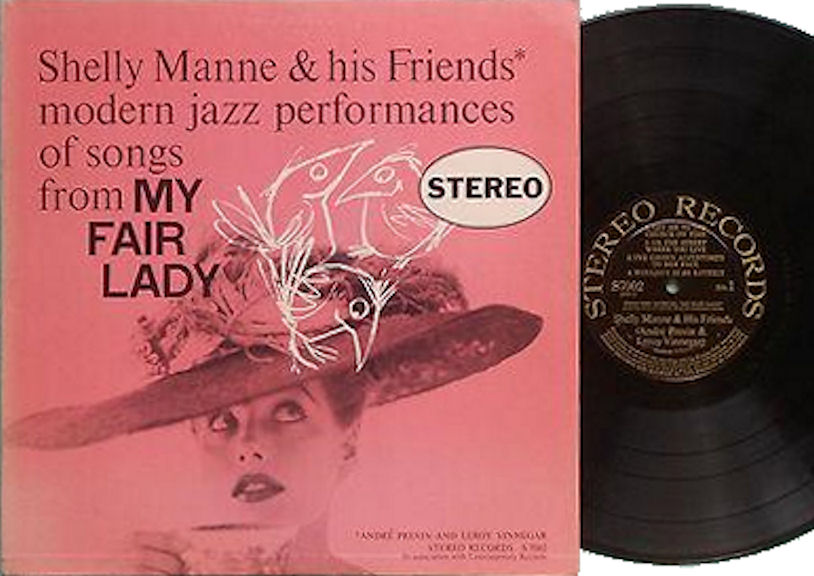 Along with these developments, this week has brought news of additional stereo releases. Audio
Fidelity, which shipped 10,000 of the four stereo titles released in March, 10 percent of its total March
output, has four more ready to go. Urania will have five releases on the market May 1, and 15 others
are now in the works. Esoteric and Counterpoint have a new release and it's reported that Hallmark will
soon have a low-priced stereo line. This release reportedly contains 14 titles. On the Coast,
Contemporary Good Time Jazz expects to have Shelly Manne's "My Fair Lady" [recorded in stereo in
1956] out in a stereo disk version [on sister label Stereo Records] "shortly." ABC-Paramount is expected
to have six stereo releases
ready for market within six weeks.
Along with these developments, this week has brought news of additional stereo releases. Audio
Fidelity, which shipped 10,000 of the four stereo titles released in March, 10 percent of its total March
output, has four more ready to go. Urania will have five releases on the market May 1, and 15 others
are now in the works. Esoteric and Counterpoint have a new release and it's reported that Hallmark will
soon have a low-priced stereo line. This release reportedly contains 14 titles. On the Coast,
Contemporary Good Time Jazz expects to have Shelly Manne's "My Fair Lady" [recorded in stereo in
1956] out in a stereo disk version [on sister label Stereo Records] "shortly." ABC-Paramount is expected
to have six stereo releases
ready for market within six weeks.
It's interesting that ABC-Paramount beat the majors to the market with stereo LPs. But where were
stereo singles in the discussion? They weren't. Not yet, but soon.
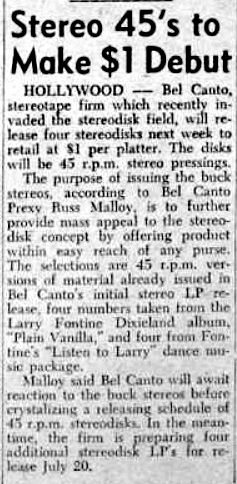 June 16, 1958, Billboard, page 2
June 16, 1958, Billboard, page 2
Stereo 45's to Make $1 Debut
Bel Canto, stereotape firm which recently invaded the stereodisk field, will release four stereodisks next
week to retail at $1 per platter. The disks will be 45 r.p.m. stereo pressings.
The purpose of issuing the buck stereos, according to Bel Canto Prexy Ross Malloy, is to further provide
mass appeal to the stereodisk concept by offering product within easy reach of any purse. The
selections are 45 r.p.m. versions of material already issued in Bel Canto's initial stereo LP release, four
numbers taken from the Larry Fontine Dixieland album, "Plain Vanilla," and four from Fontine's "Listen to
Larry" dance music package.
Malloy said Bel Canto will await reaction to the buck stereos before crystalizing a releasing schedule of
45 r.p.m. stereodisks. In the meantime, the firm is preparing four additional stereodisk LP's for release
July 20.
In retrospect, the four were slow starters, and nobody was much interested in stereo 45s. That is, until
September...
September 1, 1958, Billboard, Page 3:
Stereo Jukes by Wurlitzer
NEW YORK - Wurlitzer on Thursday (28) announced a stereo juke box. The unit consists of...
The article announced that with the new stereo juke box, a package of ten stereo RCA extended play
records will be included with each unit. RCA also promised 25 different stereo EP titles by the end of
September.
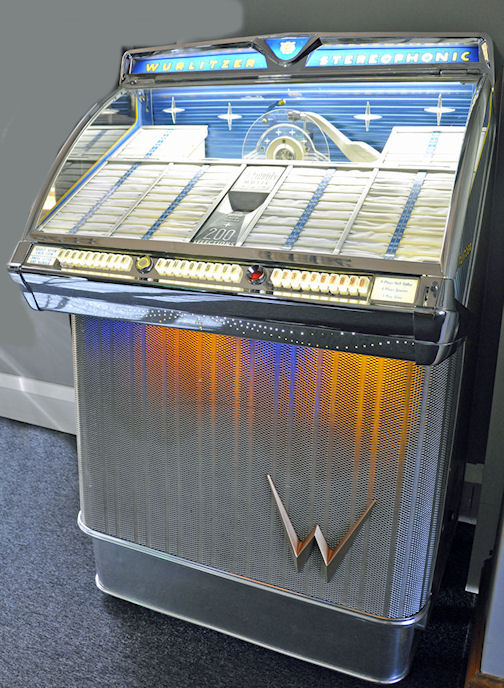 On page 68 of the same issue:
On page 68 of the same issue:
What About "45" Singles, EPs?
CHICAGO - With the introduction of a stereo jukebox principle by Wurlitzer, the immediate question
raised by the operating trade will be, how about 45 rpm singles in stereo?...
Note that the Wurlitzer announcement was for a "principle," not an actual commercial jukebox that was
ready at that time. The Wurlitzer 2300S, shown at right, was still a few months of work away.
It wouldn't be long before the idea of stereo singles heated up. In fact, by the next week...
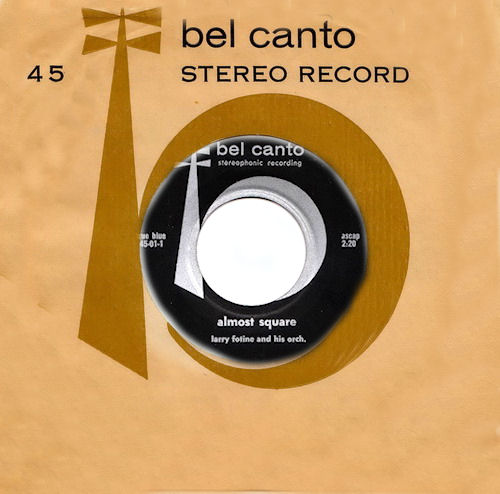 September 8, 1958, Billboard, Page 1:
September 8, 1958, Billboard, Page 1:
New Stereo Juke Unit Hypes Stereo Singles Features
Victor, Indies set for plunge; other majors conservative...
Bel Canto, a west coast tape label which recently released its original tape product in the form of
elaborately packaged stereo LPs, is the first known firm to release stereo singles, for the primary
purpose... of giving dealers a demo tool....
A guarded announcement from RCA-Victor indicates that the company "will release stereo singles in the
not too distant future." ...
MGM Records this week announced its first single - the waxing by Joni James of "There Goes My Heart"
and "Funny." The stereo single will not appear commercially at first, but rather, will be shipped to
jocks...for demo purposes.
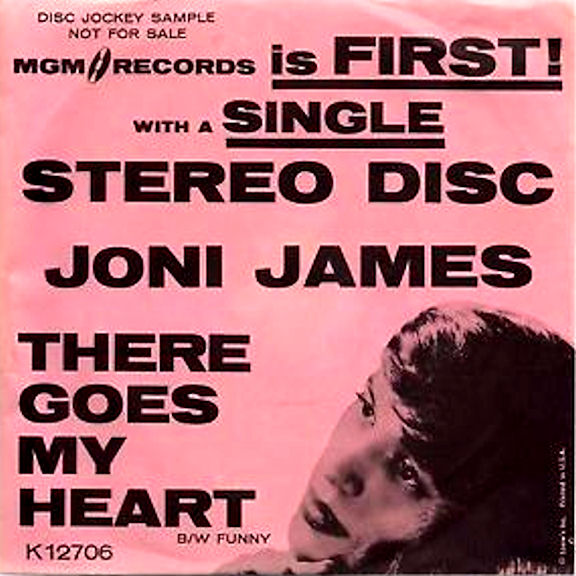 Billboard polled the various labels to find out what was planned. In summary, World Wide
Records promised stereo singles in three weeks; Imperial planned a Francis Faye single next month;
Atco was considering it; Capitol had no immediate plans; Columbia would see if demand develops;
Decca and Kapp had no plans; and Dot said "we can convert."
Billboard polled the various labels to find out what was planned. In summary, World Wide
Records promised stereo singles in three weeks; Imperial planned a Francis Faye single next month;
Atco was considering it; Capitol had no immediate plans; Columbia would see if demand develops;
Decca and Kapp had no plans; and Dot said "we can convert."
Actually, as events unfolded, it was clear that Columbia wasn't just "waiting to see if demand
developed." They were actively thinking about their failed 33-1/3 rpm single project of the "speed wars"
era (which ended a mere eight years earlier), and wondering if a stereo-33 might be a better fit for a
stereo single. So like RCA did when Columbia released the Lp, Columbia waited....
Executives were already targeting stereo singles for the adult markets, but...
It's also pointed out that teenagers are likely to be gradually "spoiled" to the wonders of the new
medium by hearing players belonging to their parents. They will want stereo, too, it's been said, even if
it's stereo rock and roll.
(A very typical statement by record executives. Remember at this point, rock and roll was still relatively
new, and most were betting on it being a passing fad.)
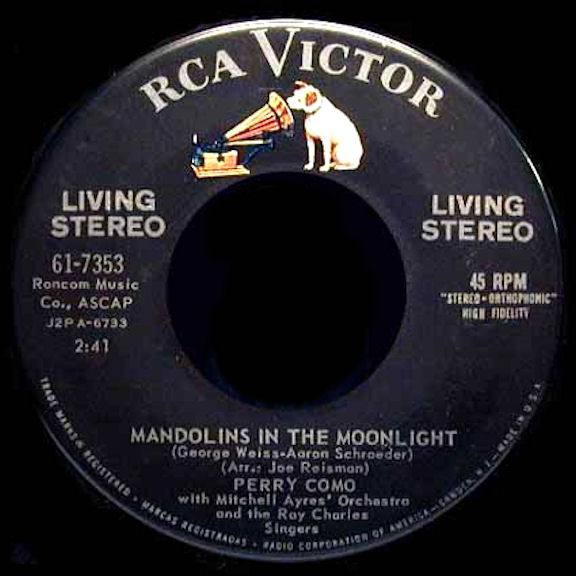
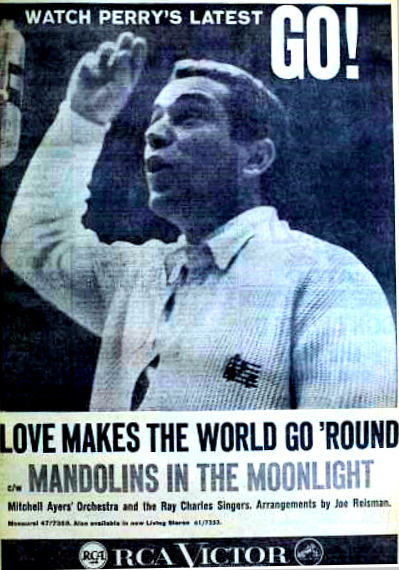 September 22, 1958, Billboard, Page 2:
September 22, 1958, Billboard, Page 2:
Victor Stereo Singles Debut
RCA announced that its first stereo single, Perry Como's "Mandolins in the Moonlight"/"Love Makes the
World Go Round," would be issued next week, for a retail price of $1.15 each plus tax.
By October 6, 1958, RCA bought a full-page ad in Billboard (page 45) that hyped the new Perry
Como disc, and noted that it was available in stereo on RCA-Victor 61-7353.
RCA-Victor was relatively early into stereo singles, and was one of the last labels to abandon them in
1961. More stereo singles were issued on 45s by RCA than by any other label.
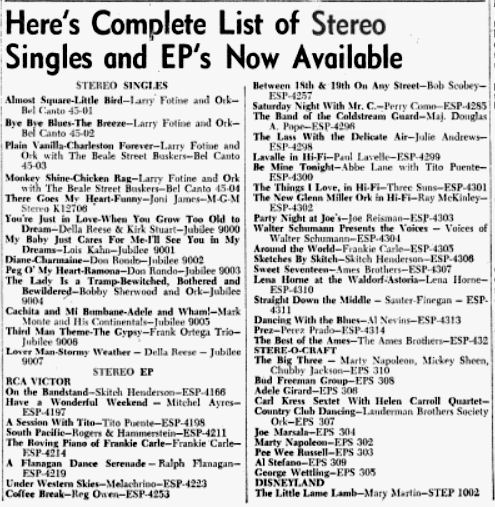 October 27, 1958, Billboard, page 69:
October 27, 1958, Billboard, page 69:
Here's Complete List of Stereo Singles and EP's Now Available
For the convenience of their juke box operator readers (the list was in the Coin Machine section),
Billboard attempted to put together a complete list of stereo 45s and stereo EPs then on the
market. On the list for stereo 45s were the four Bel Canto singles, the M-G-M promo single by Joni
James released in September, and eight stereo 45s released by Jubilee that month. Missing were the
RCA stereo singles, including the Perry Como 45 and nine others RCA announced earlier that month.
November 10, 1958, Billboard, Page 2:
RIAA Defines True Stereo Recordings
..."A true stereophonic disk record has two distinct orthogonal modulations derived from an original LIVE
recording in which a minimum of two separate channels were employed."
Individual diskeries hailed the RIAA definition as likely to bring to the consumer a clearer understanding
of stereo.
Actually, that was about as clear as mud, but...
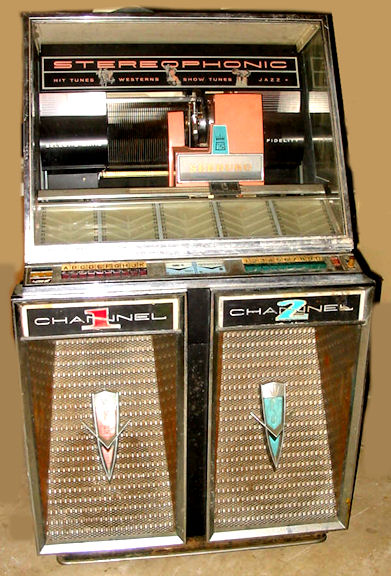 November 17, 1958, Billboard:
November 17, 1958, Billboard:
Seeburg debuts its own model 220S stereo juke box, beating their rival Wurlitzer to market with the first
stereo juke box. The same month, Wurlitzer introduced their model 2300S to distributors, with the
official launch delayed until the third week in January, 1959.
Also in the same issue, Page 29:
M-G-M Adds 9 Stereo Singles
NEW YORK - M-G-M Records has released nine new stereo singles, following up its initial stereo
release of Joni James' "There Goes My Heart" last month [sic].... A number of the label's current hottest
singles are being released in the stereo versions.
These singles are believed to be M-G-M SK-50,100 to 50,108, along the reissue of the Joni James
single, SK-50,109, making ten 45s released in all.
November 24, 1958, Billboard:
WB Enters EP Stereo Sweeps
HOLLYWOOD - Warner Bros. Records invaded the stereo EP field this week with its initial release of 18
disks. WB feels it's second only to RCA Victor in releasing stereo 45 rpm disks. Move was prompted by
the juke box industry's introduction of stereo equipment. WB's two-channel EP's will list at $1.29.
Material for the release was culled from the label's LP albums.
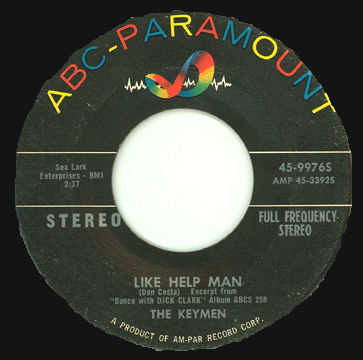 December 8, 1958, Billboard:
December 8, 1958, Billboard:
Am-Par's Hat in Stereo Singles Ring
NEW YORK - ABC-Paramount has jumped into the single stereo records market with the release of
eight stereo singles and one stereo EP. Stereo singles were released as a result of a survey ordered by
ABC-Paramount head Sam Clark, and carried out by sales chief Larry Newton. Results of their survey
was that stereo juke boxes are ready for regular releases of stereo singles right now. The firm is
releasing stereo singles featuring Eydie Gorme, Teddy Randazzo, the DeCastro Sisters, Paul Anka,
Ferrante & Teicher, and the Keymen. The stereo EP features four sides by Eydie Gorme from her best
selling albums.
December 29, 1958, Billboard, Page 4:
Roulette Debs First Stereo Singles
NEW YORK - Roulette Records has entered the stereo singles market. The label's first stereo singles
release spotlights ten disks [Roulette SSR-8001 to SSR-8009 and Tico 3001], all taken from current
Roulette stereo
LP's. The stereo singles, which retail for 98 cents, include titles by Jimmie Rodgers, Tyree Glenn, Joe
Williams, Count Basie, Joe Newman, and Marco Rizo [Tico]. Basie is represented by three separate
platters, while Rodgers and Glenn each have two singles in the stereo release.
January 19, 1959, Billboard, Page 3:
Mercury to Wax Stereo Singles, EP's for Growing Juke Demand
CHICAGO - Mercury Records this week goes into production on stereo singles and EP's to meet a
growing demand for such product from juke box operators.... Mercury's stereo 45's will be priced at 98
cents for singles and $1.29 for EP's, identical with monaural prices, it was announced.... The initial
singles release of five items, of which four are established sellers in the monaural bracket, is made up of
the Platters' "Smoke Gets In Your Eyes," Patti Page's "Trust In Me," the Gaylords' "Again," the
Diamonds' "She Say," and Dick Contino's "Dream."
In a separate story on the same page,
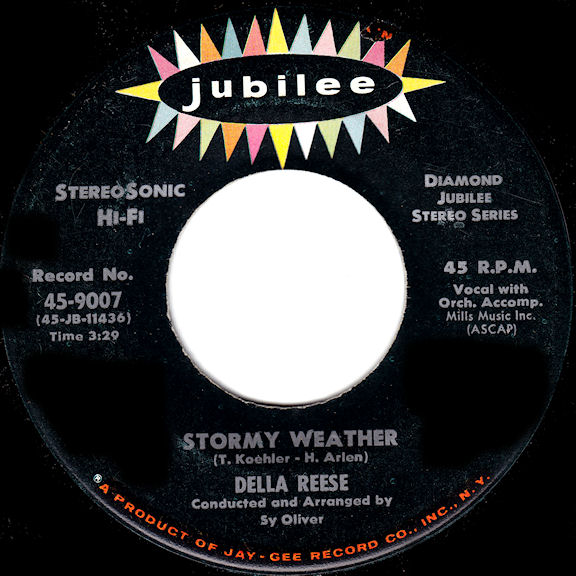 Big Potential for Stereo Singles
Big Potential for Stereo Singles
NEW YORK - Stereo singles will be playing an increasing role in the record business this year. This is
indicated by two facts - (1) four manufacturers are now marketing stereo phonos at the low price of
$39.95, and (2) two more juke box manufacturers have now entered the stereo field.... Mercury Records'
jump into the single stereo business is an indication of the attention that manufacturers are paying to this
potential new market. Up until now there have been token introductions of stereo singles and EP's, with
Victor the only firm among majors out with both EP and single stereo disks.
After a poll, Billboard reported that firms who have already released or who would soon release
stereo singles included Mercury, MGM, RCA-Victor, Jubilee, Stere-O-Craft, Omega, Am-Par, Concert
Disc, Harvest, World Wide, Savoy, and Counterpoint. Firms with stereo EPs included Decca,
RCA-Victor, King, Mercury, Bethlehem, Disneyland, Omega, Concert Disc, and Stere-O-Craft.
On Page 4, another issue that would be around for decades made its debut:
Stereo Waxing in Pioneer Stage as Techniques Vary
NEW YORK - Now that stereo records are with us for real, many A&R men, on both pop and classical
levels, are having second thoughts about how stereo should be recorded. Their second thoughts stem
from the fact that stereo recording is such a new technique that there are few ground rules, and
everyone involved in it, from the A&R man to the engineer, is really pioneering.... Currently there is
controversy over whether a stereo record should have wide separation or narrow separation, with some
firms favoring one, and vice versa. Does the consumer want to purchase a stereo record with a widely
separated band so that he really makes use of the two speakers in his equipment? Or would he rather
hear a good blend on each speaker so the recording does not sound gimmicky?
Interestingly enough, that question has never been definitively answered, but seems to depend on who
is mixing the records. In 1971, for example, wide stereo was quite in vogue, but by the end of the 1970s,
the mixing was done with much less separation. 1980s bands like the Cars favored wide stereo, while
other punk bands of the time mixed to almost-mono. Quadraphonic sound, popular for a brief time in the
mid-1970s, was either sounding like rechanneled stereo, because the back channels of QS and SQ
quad were "derived" as in the discussion above, or was discrete four channels that sounded quite
unnatural and almost unnerving to a listener (but interesting to record collectors who got the equivalent
of a four-track master they could mix themselves).
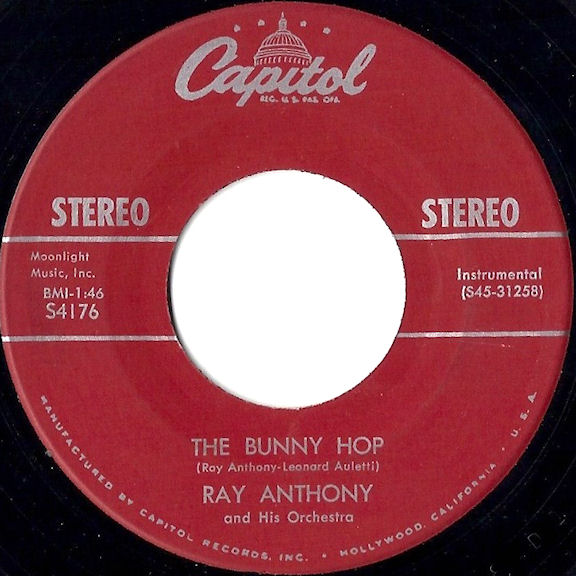 April 13, 1959, Billboard, Page 6:
April 13, 1959, Billboard, Page 6:
Capitol's Hat In Stereo Singles Ring
HOLLYWOOD - Capitol will invade the stereo singles field on April 27 with an initial release of six sides.
Four of those sides will be simultaneous stereo and one-track singles while two will be dual-track
versions of earlier monaural releases.
Four simultaneous stereo-monaural singles will feature Peggy Lee, Bobby Hammack, Ronnie & Roy and
Earl Holliman. Stereo repeats of earlier monaurals will be Ray Anthony's "Walkin' To Mothers" and
Johnny Otis "Castin' My Spell".
Disks will be $1.15 per single. Capitol won't stick to a regular stereo singles schedule but will issue
dual-track singles when it feels market demands or the material itself particularly warrants.
 May 18, 1959, Billboard.
May 18, 1959, Billboard.
On this date, the Billboard Hot 100 started indicating the hit songs that were available on a stereo
single. The first such list indicated that stereo singles were available from the following labels: Warner
Brothers, Liberty, Chancellor, Hunt, Dolphin (Dolton, issued on Liberty), ABC-Paramount, Felsted, Crest,
Capitol, RCA-Victor, Dot, Keen, Monument, M-G-M, and King.
Two of these, "Goodbye, Jimmy, Goodbye" by Kathy Linden (Felsted), and "Three Stars" by Tommy Dee
(Crest), have remained elusive over the years and may have been a communication error. One possible
explanation is that King Records may have reported the actual stereo single releases of Ruby Wright's
versions of these two songs, and somehow in the reporter's notes, the artists got confused. In any case,
research concerning the indications of stereo single availability on the Billboard Hot 100 chart
have shown that information to be generally accurate, but not 100% reliable. The inaccuracies may be
on either the record label's end (where they may have been planning a stereo single, but changed their
minds), or an error on the magazine's staff's part. Once a song was indicated to have a stereo single,
that information never changed, so if it were in error, the error was never corrected on the Hot 100 chart.
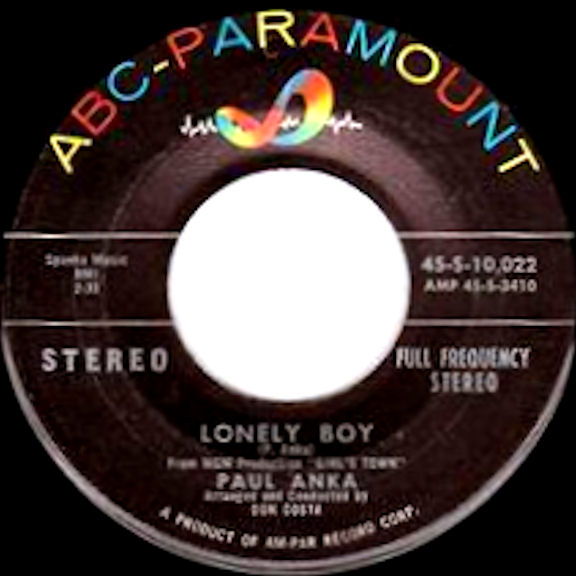 Additions for the rest of 1959 were as follows: Abner (5/25), Unart (5/25), Roulette (6/1), Dolton (on its
own label) (6/1), Original Sound (6/1), Carlton (6/8), End (6/15), Mercury (6/15), 20th Fox (6/29), Laurie
(6/29), Big Top (7/6), Jamie (7/20), Kapp (7/20), Hi-Fi (7/20), Madison (8/3), Top Rank (8/10), Ace
(8/24),
Colpix (8/24), Bethlehem (8/24), and Warwick (8/24), Columbia (9/7, on a 33), and Brunswick (9/21).
Additions for the rest of 1959 were as follows: Abner (5/25), Unart (5/25), Roulette (6/1), Dolton (on its
own label) (6/1), Original Sound (6/1), Carlton (6/8), End (6/15), Mercury (6/15), 20th Fox (6/29), Laurie
(6/29), Big Top (7/6), Jamie (7/20), Kapp (7/20), Hi-Fi (7/20), Madison (8/3), Top Rank (8/10), Ace
(8/24),
Colpix (8/24), Bethlehem (8/24), and Warwick (8/24), Columbia (9/7, on a 33), and Brunswick (9/21).
In the July 13, 1959, issue of Billboard, the first #1 song available as a stereo single appeared,
"Lonely Boy" by Paul Anka.
By the July 27, 1959, issue, 12 of the top 20 songs were listed as being available on stereo single (and
21 of the top 40), indicating that the record labels were issuing stereo singles for the big hits. But July,
1959, was apparently the zenith of popularity for the stereo 45. At that point, it had been about a year
that stereo 45s had been around, and record labels were assessing how well they were selling. And they
weren't liking what they were seeing.
By August, the big stereo 45 boom had seemingly peaked. Fewer labels were being added, and
fewer songs were available on stereo single.
Columbia, never a fan of RCA-Victor's 45, even in stereo, you'll recall had been "waiting to see if a
demand developed." They waited throughout the whole stereo 45 buildup and decided they didn't want
to issue any. Instead, with the stereo 45 peak just passed, they decided to take out their old 7" 33-1/3
rpm idea and see if their 33-singles would catch on as stereo singles.
By the end of the year, only 9 of the top 20 were available on stereo single, and 14 of the top 40. And
since September, no new labels had released stereo singles for the first time. By the start of 1960,
record labels were having second thoughts about the stereo 45. Also, for the releases of stereo 45s in
1960, far fewer copies seem to have been pressed.
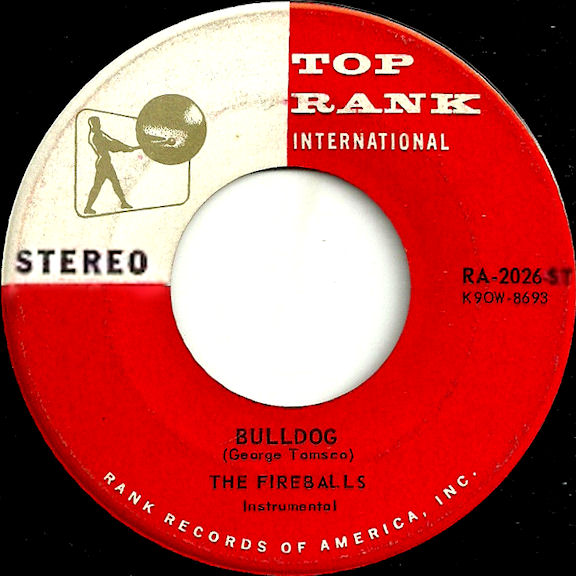 In the January 16, 1960 edition of Billboard, the Hot 100 first listed the Fireballs' "Bulldog" as
being available on stereo 45. This has been one of the most frustrating stereo singles for collectors to
find, and the offering may have been cancelled. Released about the same time as the stereo single for
"What In The World's Come Over You" by Jack Scott, it probably would also have had the red stereo
single label, as show by the FAKE label illustration at right.
In the January 16, 1960 edition of Billboard, the Hot 100 first listed the Fireballs' "Bulldog" as
being available on stereo 45. This has been one of the most frustrating stereo singles for collectors to
find, and the offering may have been cancelled. Released about the same time as the stereo single for
"What In The World's Come Over You" by Jack Scott, it probably would also have had the red stereo
single label, as show by the FAKE label illustration at right.
Three weeks later, another "phantom" stereo single was listed. In the February 1, 1960, issue of
Billboard, Lloyd Price's "Lady Luck" was listed as available on stereo single. No one has
seemingly found a copy of that one either, in over 50 years of looking.
By February 1, only five of the top 20 songs were available on stereo singles, and only 12 of the top 40.
Changes were coming.
On February 8, 1960, probably because of pressure from Columbia, Billboard began listing stereo
45 and stereo 33 availability separately. Immediately, five Columbia stereo singles on 33-1/3 rpm
appeared on the Hot 100.
 In the June 6, 1960, issue of Billboard, "One of Us (Will Weep Tonight)" by Patti Page is the last
new stereo single listed for some time. By August 1, 1959, there are no songs in the top 20 available on
stereo single, according to Billboard, and by August 22, there are no stereo singles among the
top 40. By September 5, the Hot 100 has no more stereo singles listed. The last one, "One of Us (Will
Weep Tonight)", was last on the August 29 chart at #61. It looks like the stereo single experiment is
over, but this was apparently just a lapse in Billboard's staff getting the information from the
record labels. On September 19, 1959, 16 stereo 45s and 3 of Columbia's stereo 33s are suddenly
listed.
In the June 6, 1960, issue of Billboard, "One of Us (Will Weep Tonight)" by Patti Page is the last
new stereo single listed for some time. By August 1, 1959, there are no songs in the top 20 available on
stereo single, according to Billboard, and by August 22, there are no stereo singles among the
top 40. By September 5, the Hot 100 has no more stereo singles listed. The last one, "One of Us (Will
Weep Tonight)", was last on the August 29 chart at #61. It looks like the stereo single experiment is
over, but this was apparently just a lapse in Billboard's staff getting the information from the
record labels. On September 19, 1959, 16 stereo 45s and 3 of Columbia's stereo 33s are suddenly
listed.
By 1961, stereo singles dwindled down to a mere trickle, with RCA-Victor and ABC-Paramount the last
holdouts. Fewer and fewer stereo 45s appeared on the Hot 100, until April 10, 1961, when there were
none. The last stereo 45 to be listed was Ferrante & Teicher's "Exodus." Columbia still had their
stereo-7 33s for two weeks after that, with Marty Robbins' "Don't Worry" the last listed stereo-33, which
was last sighted April 17, 1961. The next week, even though "Don't Worry" was still on the charts, all
indications of stereo singles were gone. For all intents and purposes, the commercial stereo single
experiment was over. It had lasted just under three years.
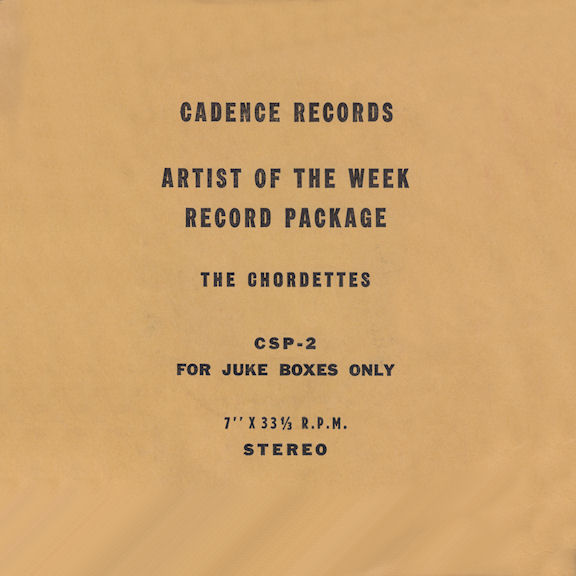 With the commercial failure of the stereo single in 1961, the stereo-33 was still being made for juke
boxes. In fact, by this time almost all the stereo-33 singles were being packaged in groups of five and
shipped to the jukebox companies as "Artist of the Week" offerings. Not
surprisingly, it was the stereo juke box that started the whole stereo single thing, and those stereo juke
boxes
still provided an outlet for the discs after the big dreams for commercial success of the stereo single had
faded away. This will be covered in Part 2.
With the commercial failure of the stereo single in 1961, the stereo-33 was still being made for juke
boxes. In fact, by this time almost all the stereo-33 singles were being packaged in groups of five and
shipped to the jukebox companies as "Artist of the Week" offerings. Not
surprisingly, it was the stereo juke box that started the whole stereo single thing, and those stereo juke
boxes
still provided an outlet for the discs after the big dreams for commercial success of the stereo single had
faded away. This will be covered in Part 2.
The commercial failure of both stereo 45s and stereo 33s left the industry to tinker with other formats. In
the spring of 1961, just as the stereo singles were making an exit from the charts, the idea of 33 1/3 rpm
EPs was tried. The first to attempt to sell the "compact double" to record stores was (surprisingly
enough) Parkway Records, who put out a Chubby Checker mono-33 EP with four songs. Capitol and
RCA quickly tried their hands in it, but they all found the same thing: no sales to speak of. All abandoned
the idea.
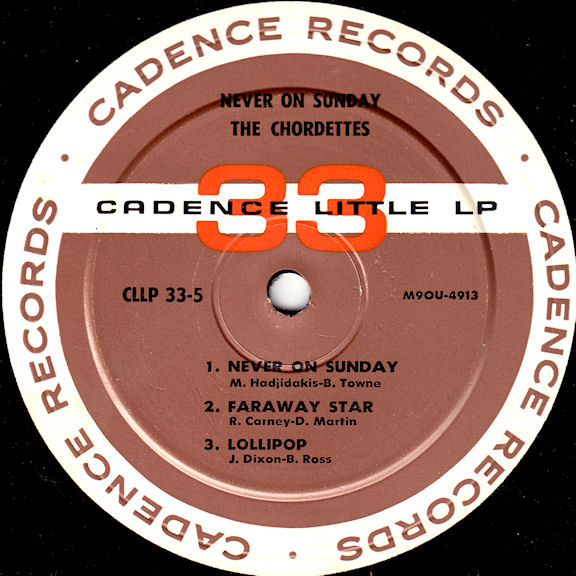 In October, 1961, Archie Bleyer at Cadence put out six mono discs with three songs on each side. He
called them "Little LPs," and the name stuck. His first approach was to try to sell them in record stores
and even grocery stores, but again, sales were dismal. He soon gave up the idea, as did Mercury, who
tried Bleyer's idea with ten of their own Little LPs. Later, an exec at Mercury summed up the Little LP
sales in 1961 as "Bombsville."
In October, 1961, Archie Bleyer at Cadence put out six mono discs with three songs on each side. He
called them "Little LPs," and the name stuck. His first approach was to try to sell them in record stores
and even grocery stores, but again, sales were dismal. He soon gave up the idea, as did Mercury, who
tried Bleyer's idea with ten of their own Little LPs. Later, an exec at Mercury summed up the Little LP
sales in 1961 as "Bombsville."
But Seeburg, the jukebox company, saw some real potential in these Little LP discs. They developed a
new jukebox by late summer, 1962, and talked more than a dozen record labels into providing stereo
Little LPs for jukebox use. By this time, everyone agreed (even Columbia) that trying to sell 7" 33 1/3
rpm records to the public wasn't working. But using Little LPs in jukeboxes to promote the sale of full
LPs was a decent enough idea. And so it started. By January, 1963, Seeburg had some 233 Little LPs in
their catalog, and this swelled to over a thousand by 1966. Little LPs (called "jukebox EPs" by collectors
for years), had their place, and it was always the jukebox, never the commercial record store. This will
be covered in Part 3.
Finally, we get back to the "compatibility" issue. Remember that in 1958, stereo records were
"incompatible" with mono players because the cartridges in mono players had no vertical give, and
would damage records? Starting in 1958, mono cartridges were also built with vertical flexibility, and by
1968, the record companies realized that the really old mono players with the old cartridges were almost
all flushed out of the system. So, they began making singles stereo only, and dropped mono albums,
too. What was this new "compatible" disc? Actually, it was the same old stereo disc that was
incompatible in 1958, it was just that the mono players had changed. So when they said, "Compatible
stereo, playable on most modern monaural phonographs", they weren't talking innovation, they were
talking about the 1950s mono players being obsolete (although there were a few technical wrinkles that
needed to be worked out). The reintroduction of stereo on singles starting in 1968 is covered in Part 4.
We would appreciate any additions or corrections to this discography. Just send them to us via e-mail. Both Sides Now Publications is an information
web page. We are not a catalog, nor can we provide the records listed below. We have no association
with any of these record labels. Should you be interested in acquiring the stereo singles listed in this
discography (which are all out of print), we suggest you see our Frequently Asked Questions page and follow the
instructions found there. This story and discography are copyright 2014 by Mike Callahan.
Thanks to Dave Dzurick, Barry Margolis, and Thomas Reed.
 On to Part 1. Early Stereo 45s (1958-1961)
On to Part 1. Early Stereo 45s (1958-1961)
 On to Part 2. Stereo-33 Singles (1959-1964)
On to Part 2. Stereo-33 Singles (1959-1964)
 On to Part 3. Compact-33 Juke Box LPs
On to Part 3. Compact-33 Juke Box LPs
 On to Part 4. Re-introduction of Stereo on 45s (1968-1972)
On to Part 4. Re-introduction of Stereo on 45s (1968-1972)
 Back to the Discography Listings Page
Back to the Discography Listings Page
 Back to the Both Sides Now Home Page
Back to the Both Sides Now Home Page
 Both companies were known to be working on hush-hush projects to basically replace the 78. Columbia
got to the announcement stage first. In late May, 1948, Columbia announced a new type of record, one
that would run at 33-1/3 rpm and be pressed on vinyl. (RCA had
introduced a 33-1/3 rpm long playing disc in 1931, although this one offered several improvements.)
The new disc would, unlike the 78s, use a much smaller groove (microgroove) with an ultra light
tonearm and a new type of cartridge/stylus. They called the new innovation the Lp (big "L", small "p") for
"long playing." The new type of record minimized surface noise, the quiet backgrounds being perfect for
classical music, with longer playing times of 22 minutes or so per side for a 12" Lp. In fact, Columbia's
idea at the time was to use Lp for their Mastersound records, which is where the classical and other
highbrow music resided. The industry was energized by the news (see headline at right from
Billboard, 5/29/48). By the next week, phonograph makers were rushing to build units that could
play the new records, the first of which were due in June.
Both companies were known to be working on hush-hush projects to basically replace the 78. Columbia
got to the announcement stage first. In late May, 1948, Columbia announced a new type of record, one
that would run at 33-1/3 rpm and be pressed on vinyl. (RCA had
introduced a 33-1/3 rpm long playing disc in 1931, although this one offered several improvements.)
The new disc would, unlike the 78s, use a much smaller groove (microgroove) with an ultra light
tonearm and a new type of cartridge/stylus. They called the new innovation the Lp (big "L", small "p") for
"long playing." The new type of record minimized surface noise, the quiet backgrounds being perfect for
classical music, with longer playing times of 22 minutes or so per side for a 12" Lp. In fact, Columbia's
idea at the time was to use Lp for their Mastersound records, which is where the classical and other
highbrow music resided. The industry was energized by the news (see headline at right from
Billboard, 5/29/48). By the next week, phonograph makers were rushing to build units that could
play the new records, the first of which were due in June.
 In June, Columbia held a "technical press conference" in New York for industry folks, explaining the
development process for the Lp, demonstrating the discs, and going through all the technical
specifications (Billboard story, 6/26/48, at left). They talked about the availability of phonographs.
They also offered their new technology to any other labels who wanted them. Labels like the brand-new
Mercury Records jumped at the offer, but RCA-Victor declined.
In June, Columbia held a "technical press conference" in New York for industry folks, explaining the
development process for the Lp, demonstrating the discs, and going through all the technical
specifications (Billboard story, 6/26/48, at left). They talked about the availability of phonographs.
They also offered their new technology to any other labels who wanted them. Labels like the brand-new
Mercury Records jumped at the offer, but RCA-Victor declined.
 Also on January 8, 1949, a story in Billboard (page 3) revealed details of the new RCA-Victor 45
rpm disc. Unlike the 78s of the time, or Columbia's Lp, it would have a large 1-5/8" hole in the center,
and would work with a new RCA record changer with the thick spindle. The record, measuring 6-7/8
inches in diameter, would use only about an inch of the outside of the record for grooves. RCA
engineers had designed it "with the express objective of achieving 100 percent undistortion, or put
another way, creating a record which is completely free of surface noises or distortion of any kind."
Persons at the time who heard the new disc reported that as far as they could tell, RCA engineers had
accomplished their goal.
Also on January 8, 1949, a story in Billboard (page 3) revealed details of the new RCA-Victor 45
rpm disc. Unlike the 78s of the time, or Columbia's Lp, it would have a large 1-5/8" hole in the center,
and would work with a new RCA record changer with the thick spindle. The record, measuring 6-7/8
inches in diameter, would use only about an inch of the outside of the record for grooves. RCA
engineers had designed it "with the express objective of achieving 100 percent undistortion, or put
another way, creating a record which is completely free of surface noises or distortion of any kind."
Persons at the time who heard the new disc reported that as far as they could tell, RCA engineers had
accomplished their goal.
 The long Billboard story on January 8 concluded this way: "While wiseacre trade comment anent
RCA's new disk has run along the general lines that the diskery would not sit still for Columbia beating
them to the punch with the 33 1/3 long-playing platter, that RCA would find a way of "getting even," the
facts behind the new system are these: As is the custom with all its many products, engineering
research has gone on in the record division for a long time. As far back as late 1938 the RCA engineers
were diddling, not with a new type record, but with a complete phonograph system, which would give
completely undistorted music. The record player which will be introduced in March or April of 1949 were
actually developed for all practical purposes in late 1946.... In the summer of 1948 when Columbia
introduced its long playing 33 1/3 microgrooved disk and won the support of key instrument
manufacturers, RCA decided the time had come to get serious about introducing their own version of a
new standard. In view of the engineering research, production and other planning necessary to ready
and launch such an item it seems ridiculous to believe that pique over the Columbia move dictated the
RCA entry... However, there is little doubt that the introduction of the new RCA player and platter in the
spring will mark the beginning of a historic disk battle between the Camden characters [RCA] and the
Columbia gang from Bridgeport." Speed wars, indeed.
The long Billboard story on January 8 concluded this way: "While wiseacre trade comment anent
RCA's new disk has run along the general lines that the diskery would not sit still for Columbia beating
them to the punch with the 33 1/3 long-playing platter, that RCA would find a way of "getting even," the
facts behind the new system are these: As is the custom with all its many products, engineering
research has gone on in the record division for a long time. As far back as late 1938 the RCA engineers
were diddling, not with a new type record, but with a complete phonograph system, which would give
completely undistorted music. The record player which will be introduced in March or April of 1949 were
actually developed for all practical purposes in late 1946.... In the summer of 1948 when Columbia
introduced its long playing 33 1/3 microgrooved disk and won the support of key instrument
manufacturers, RCA decided the time had come to get serious about introducing their own version of a
new standard. In view of the engineering research, production and other planning necessary to ready
and launch such an item it seems ridiculous to believe that pique over the Columbia move dictated the
RCA entry... However, there is little doubt that the introduction of the new RCA player and platter in the
spring will mark the beginning of a historic disk battle between the Camden characters [RCA] and the
Columbia gang from Bridgeport." Speed wars, indeed.
 RCA made the first 12 45-rpm singles available the week of April 16, 1949, and announced that starting
with the April 29 release, all new releases would be made on both 45-rpm and 78-rpm discs. The
advertisement above left is from the April 23, 1949, issue of Billboard, and marks the first time
45-rpm singles were available. With the release of these singles, customers noticed an interesting
bonus: they were all on colored vinyl, with "popular classics" (Broadway musicals and operettas) having
a dark blue label and dark blue vinyl , green labels and vinyl for country, yellow vinyl with a dark blue
label for childrens' records, a crimson red label and vinyl for classical music, rhythm and blues on cerise
(orange) vinyl with a flat black label (often hard to read, and often these records had very low volume),
and international with a shiny black label on teal vinyl. Regular pop singles were issued on black vinyl
with blue labels. It was a matter of only a year or two, however, before RCA started pressing all the 45s
on black vinyl.
RCA made the first 12 45-rpm singles available the week of April 16, 1949, and announced that starting
with the April 29 release, all new releases would be made on both 45-rpm and 78-rpm discs. The
advertisement above left is from the April 23, 1949, issue of Billboard, and marks the first time
45-rpm singles were available. With the release of these singles, customers noticed an interesting
bonus: they were all on colored vinyl, with "popular classics" (Broadway musicals and operettas) having
a dark blue label and dark blue vinyl , green labels and vinyl for country, yellow vinyl with a dark blue
label for childrens' records, a crimson red label and vinyl for classical music, rhythm and blues on cerise
(orange) vinyl with a flat black label (often hard to read, and often these records had very low volume),
and international with a shiny black label on teal vinyl. Regular pop singles were issued on black vinyl
with blue labels. It was a matter of only a year or two, however, before RCA started pressing all the 45s
on black vinyl.
 Stereophonic sound was not new in the late 1950s. People were investigating stereo as early as the
1880s, and probably long before that. Bell Laboratories in New York City gave a demonstration of
stereo in 1937, and motion pictures started using some of the techniques around the same time. Walt
Disney's Fantasia was partly recorded in stereophonic sound, which was restored in 1956.
Movies as early as 1953 let viewers in theaters hear the films in stereo. By 1955, recorded music was
being offered to the public on four-track (two-tracks each direction) reel-to-reel tape. The challenge was
how to bring stereo to disc.
Stereophonic sound was not new in the late 1950s. People were investigating stereo as early as the
1880s, and probably long before that. Bell Laboratories in New York City gave a demonstration of
stereo in 1937, and motion pictures started using some of the techniques around the same time. Walt
Disney's Fantasia was partly recorded in stereophonic sound, which was restored in 1956.
Movies as early as 1953 let viewers in theaters hear the films in stereo. By 1955, recorded music was
being offered to the public on four-track (two-tracks each direction) reel-to-reel tape. The challenge was
how to bring stereo to disc.
 Audio Fidelity Records was the first to solve both problems. They developed a system for stereo on vinyl
records in 1957 with several prototype demonstration discs, but problems with reproduction on a mass
scale left the industry skeptical. On December, 13, 1957, they stunned the industry with an actual
workable, mass-produced disc that had gone through a press run of 500 copies. Unlike previous
attempts by others, this disc required only a single stylus. The first stereo disc had The Dukes of
Dixieland on one side and train sounds on the other (see above right).
Audio Fidelity Records was the first to solve both problems. They developed a system for stereo on vinyl
records in 1957 with several prototype demonstration discs, but problems with reproduction on a mass
scale left the industry skeptical. On December, 13, 1957, they stunned the industry with an actual
workable, mass-produced disc that had gone through a press run of 500 copies. Unlike previous
attempts by others, this disc required only a single stylus. The first stereo disc had The Dukes of
Dixieland on one side and train sounds on the other (see above right).
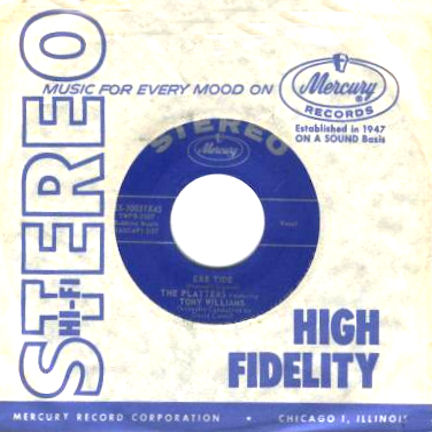 The Stereo Singles Project
The Stereo Singles Project Along with these developments, this week has brought news of additional stereo releases. Audio
Fidelity, which shipped 10,000 of the four stereo titles released in March, 10 percent of its total March
output, has four more ready to go. Urania will have five releases on the market May 1, and 15 others
are now in the works. Esoteric and Counterpoint have a new release and it's reported that Hallmark will
soon have a low-priced stereo line. This release reportedly contains 14 titles. On the Coast,
Contemporary Good Time Jazz expects to have Shelly Manne's "My Fair Lady" [recorded in stereo in
1956] out in a stereo disk version [on sister label Stereo Records] "shortly." ABC-Paramount is expected
to have six stereo releases
ready for market within six weeks.
Along with these developments, this week has brought news of additional stereo releases. Audio
Fidelity, which shipped 10,000 of the four stereo titles released in March, 10 percent of its total March
output, has four more ready to go. Urania will have five releases on the market May 1, and 15 others
are now in the works. Esoteric and Counterpoint have a new release and it's reported that Hallmark will
soon have a low-priced stereo line. This release reportedly contains 14 titles. On the Coast,
Contemporary Good Time Jazz expects to have Shelly Manne's "My Fair Lady" [recorded in stereo in
1956] out in a stereo disk version [on sister label Stereo Records] "shortly." ABC-Paramount is expected
to have six stereo releases
ready for market within six weeks.
 June 16, 1958, Billboard, page 2
June 16, 1958, Billboard, page 2
 On page 68 of the same issue:
On page 68 of the same issue:
 September 8, 1958, Billboard, Page 1:
September 8, 1958, Billboard, Page 1:
 Billboard polled the various labels to find out what was planned. In summary, World Wide
Records promised stereo singles in three weeks; Imperial planned a Francis Faye single next month;
Atco was considering it; Capitol had no immediate plans; Columbia would see if demand develops;
Decca and Kapp had no plans; and Dot said "we can convert."
Billboard polled the various labels to find out what was planned. In summary, World Wide
Records promised stereo singles in three weeks; Imperial planned a Francis Faye single next month;
Atco was considering it; Capitol had no immediate plans; Columbia would see if demand develops;
Decca and Kapp had no plans; and Dot said "we can convert."

 September 22, 1958, Billboard, Page 2:
September 22, 1958, Billboard, Page 2:
 October 27, 1958, Billboard, page 69:
October 27, 1958, Billboard, page 69:
 November 17, 1958, Billboard:
November 17, 1958, Billboard:
 December 8, 1958, Billboard:
December 8, 1958, Billboard:
 Big Potential for Stereo Singles
Big Potential for Stereo Singles
 April 13, 1959, Billboard, Page 6:
April 13, 1959, Billboard, Page 6:
 May 18, 1959, Billboard.
May 18, 1959, Billboard.
 Additions for the rest of 1959 were as follows: Abner (5/25), Unart (5/25), Roulette (6/1), Dolton (on its
own label) (6/1), Original Sound (6/1), Carlton (6/8), End (6/15), Mercury (6/15), 20th Fox (6/29), Laurie
(6/29), Big Top (7/6), Jamie (7/20), Kapp (7/20), Hi-Fi (7/20), Madison (8/3), Top Rank (8/10), Ace
(8/24),
Colpix (8/24), Bethlehem (8/24), and Warwick (8/24), Columbia (9/7, on a 33), and Brunswick (9/21).
Additions for the rest of 1959 were as follows: Abner (5/25), Unart (5/25), Roulette (6/1), Dolton (on its
own label) (6/1), Original Sound (6/1), Carlton (6/8), End (6/15), Mercury (6/15), 20th Fox (6/29), Laurie
(6/29), Big Top (7/6), Jamie (7/20), Kapp (7/20), Hi-Fi (7/20), Madison (8/3), Top Rank (8/10), Ace
(8/24),
Colpix (8/24), Bethlehem (8/24), and Warwick (8/24), Columbia (9/7, on a 33), and Brunswick (9/21).
 In the January 16, 1960 edition of Billboard, the Hot 100 first listed the Fireballs' "Bulldog" as
being available on stereo 45. This has been one of the most frustrating stereo singles for collectors to
find, and the offering may have been cancelled. Released about the same time as the stereo single for
"What In The World's Come Over You" by Jack Scott, it probably would also have had the red stereo
single label, as show by the FAKE label illustration at right.
In the January 16, 1960 edition of Billboard, the Hot 100 first listed the Fireballs' "Bulldog" as
being available on stereo 45. This has been one of the most frustrating stereo singles for collectors to
find, and the offering may have been cancelled. Released about the same time as the stereo single for
"What In The World's Come Over You" by Jack Scott, it probably would also have had the red stereo
single label, as show by the FAKE label illustration at right.
 In the June 6, 1960, issue of Billboard, "One of Us (Will Weep Tonight)" by Patti Page is the last
new stereo single listed for some time. By August 1, 1959, there are no songs in the top 20 available on
stereo single, according to Billboard, and by August 22, there are no stereo singles among the
top 40. By September 5, the Hot 100 has no more stereo singles listed. The last one, "One of Us (Will
Weep Tonight)", was last on the August 29 chart at #61. It looks like the stereo single experiment is
over, but this was apparently just a lapse in Billboard's staff getting the information from the
record labels. On September 19, 1959, 16 stereo 45s and 3 of Columbia's stereo 33s are suddenly
listed.
In the June 6, 1960, issue of Billboard, "One of Us (Will Weep Tonight)" by Patti Page is the last
new stereo single listed for some time. By August 1, 1959, there are no songs in the top 20 available on
stereo single, according to Billboard, and by August 22, there are no stereo singles among the
top 40. By September 5, the Hot 100 has no more stereo singles listed. The last one, "One of Us (Will
Weep Tonight)", was last on the August 29 chart at #61. It looks like the stereo single experiment is
over, but this was apparently just a lapse in Billboard's staff getting the information from the
record labels. On September 19, 1959, 16 stereo 45s and 3 of Columbia's stereo 33s are suddenly
listed.
 With the commercial failure of the stereo single in 1961, the stereo-33 was still being made for juke
boxes. In fact, by this time almost all the stereo-33 singles were being packaged in groups of five and
shipped to the jukebox companies as "Artist of the Week" offerings. Not
surprisingly, it was the stereo juke box that started the whole stereo single thing, and those stereo juke
boxes
still provided an outlet for the discs after the big dreams for commercial success of the stereo single had
faded away. This will be covered in Part 2.
With the commercial failure of the stereo single in 1961, the stereo-33 was still being made for juke
boxes. In fact, by this time almost all the stereo-33 singles were being packaged in groups of five and
shipped to the jukebox companies as "Artist of the Week" offerings. Not
surprisingly, it was the stereo juke box that started the whole stereo single thing, and those stereo juke
boxes
still provided an outlet for the discs after the big dreams for commercial success of the stereo single had
faded away. This will be covered in Part 2.
 In October, 1961, Archie Bleyer at Cadence put out six mono discs with three songs on each side. He
called them "Little LPs," and the name stuck. His first approach was to try to sell them in record stores
and even grocery stores, but again, sales were dismal. He soon gave up the idea, as did Mercury, who
tried Bleyer's idea with ten of their own Little LPs. Later, an exec at Mercury summed up the Little LP
sales in 1961 as "Bombsville."
In October, 1961, Archie Bleyer at Cadence put out six mono discs with three songs on each side. He
called them "Little LPs," and the name stuck. His first approach was to try to sell them in record stores
and even grocery stores, but again, sales were dismal. He soon gave up the idea, as did Mercury, who
tried Bleyer's idea with ten of their own Little LPs. Later, an exec at Mercury summed up the Little LP
sales in 1961 as "Bombsville."
 On to Part 1. Early Stereo 45s (1958-1961)
On to Part 1. Early Stereo 45s (1958-1961)